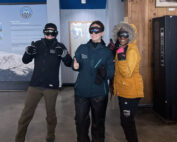Fogbow!
2010-10-05 18:21:09.000 – Ryan Knapp, Staff Meteorologist
Single fogbow!…What does it mean?
This afternoon, Brian came in exclaiming that there was a pretty neat fogbow to the east. I have seen these before but like most things involved in weather, I am more than happy to see them again. So I grabbed my trusty camera and ran up to the observation deck. As soon as I popped out the door, there it was, a complete fogbow stretching over the northeast sky. Unable to see anything in my cameras tiny screen due to the bright sunlight, I just aimed in the general direction of the bow and shot away hoping for some success (the beauty of digital cameras). The entire time I was shooting, I kept hearing “Oh, look at the rainbow!” And in my mind, in the voice of Arnold Schwarzenegger from Kindergarten Cop when he exclaimed, “It’s not a tumor!” I kept thinking “It’s not a rainbow!”
While I didn’t say anything while I was outside to avoid a ton of questions, I did think it would be a great opportunity for an observer comment to act as a refresher on what a fogbow is. A fogbow goes by many names (mistbow, cloudbow, Bouguer’s halo, Ulloa’s ring, sea-dog, or white rainbow), and are typically seen from mountain tops or airplanes but can be seen, on rare occasions, in valley fog. A fogbow, similar to a rainbow, requires a bright light to your back (typically the sun) and moisture in the air for the lightwaves to interact with to emit a large circle in the opposite direction of the light source. But fogbows, unlike rainbows, appear pale, with muted colors (typically reds and blues) or no colors at all. Fogbows tend to be larger than rainbows and reach maximum intensity at a different angle than rainbows. The droplets that typically form these are about 50 μm (micrometer) where as rainbows are formed by droplets reaching a few millimeters (mm) or more. The larger droplets that form rainbows refract and reflect light where as the smaller droplets diffract and reflect the light passing through. In other words, the larger droplets spread out the light waves as they pass through creating a spectrum where as the smaller droplets bend the light inward causing the exiting light to mutually interfere with itself bringing regions of enhanced brilliance, constructive interference, and destructive interference. So in a fogbow, you get bands of bright white and “dark white” and everything in between creating a “false-spectrum” of sorts.
I could ramble on about how they are formed getting real technical but these are the key points in how this optical phenomena occurs. If you want to learn more about them and get down and dirty with all things fogbow, you can check out the paper entitled “Rainbows and Fogbows” by David Lynch and Ptolemy Schwartz (a paper I hadn’t read, until today, since college) or the Atmospheric Optics page which, in my opinion, is the best online resource for all things relating to sights you may see in the atmosphere (to navigate, just click on the words in the left hand column on the page or anything underlined). And hopefully after reading my comment and the online resources, the next time you are with a friend who keeps saying “Look at the rainbow”, you can say “Well, actually that’s a fogbow. Let me tell you a little about them…”
Ryan Knapp, Staff Meteorologist
Team Flags Return for Seek the Peak’s 25th Anniversary
Team Flags Return for Seek the Peak's 25th Anniversary By MWOBS Staff Mount Washington Observatory is looking forward to continuing a much-loved tradition for Seek the Peak’s 25th Anniversary: Team flags. In inviting teams
Meet Summer Interns Zakiya, Max and Maddie
Meet Summer Interns Zakiya, Max and Maddie By MWOBS Staff We are excited to welcome six teammates to the summit of Mount Washington this summer! During their internship, these students and graduates will play
Saying Goodbye to the Summit
Saying Goodbye to the Summit By Alexis George After an extraordinary last three years working as a Weather Observer and Meteorologist, I am excited to pursue a different career. As sad I as am






